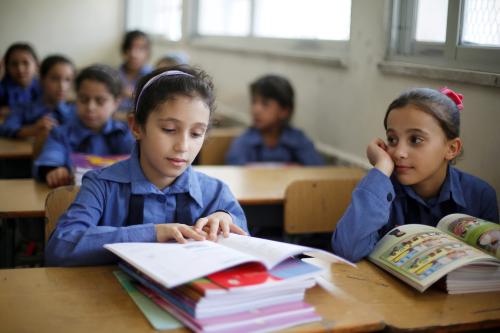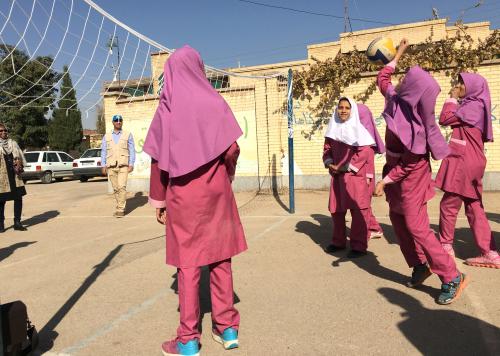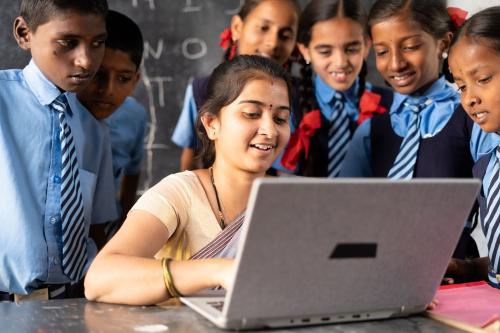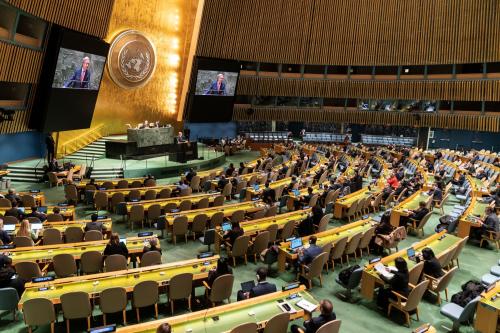When development stakeholders discuss the need to engage girls in science, conversations stagnate around increasing female participation across science, technology, engineering, and mathematics (STEM) subjects in school. Yet, the reason we believe girls should be present in science goes beyond a concern with parity for parity’s sake. Ignoring half of the population, in and of itself, limits our potential to solve the world’s most pressing challenges. Women and girls bear the greatest burdens of poverty, natural disasters, and political violence. Meanwhile, solution-makers are seldom aware of what experiences, perspectives, and ideas women and girls can bring to the table. Increasing female participation to solve the problems that burden them most is a commonsense approach to addressing the fundamental development challenges of our time.
How can we help increase girls’ engagement in research, science, and technology? Here are three approaches to help deepen the global discussion on International Day of Women and Girls in Science:
- Disrupt the stereotypes that keep girls out of science and research.
We have celebrated progress on female enrollment at higher levels of education, with women even surpassing men in some countries. Bachelor and master’s degrees can account for much of this progress, but figures for doctoral studies and professional research drop significantly. Across the world, some of the highest paying jobs are in the natural sciences and engineering. But cultural stereotypes and domestic expectations take women and girls off the path to accessing such opportunities.
In Nigeria, for instance, only 30 percent of doctoral students and 23 percent of researchers are female. Brookings Echidna Global Scholar Adefunke Ekine, found that gender biases are embedded in Nigerian science curricula, influencing both girls’ achievement in science subjects and teachers’ attitudes in the classroom. Due to teacher bias, girls are allotted less time to complete science tasks and do not receive the same positive feedback from teachers as their male counterparts. Since her research at Brookings, Ekine has conducted gender sensitization training with over 300 primary education teachers, focusing on disrupting some of the stereotypes that hold female students back. After the first year of the teacher training, girls’ science enrollment in one school went up by 33 percent, demonstrating how critical gender-sensitive pedagogy can be for girls’ achievement.
- Put girls at the center of the technology revolution.
As technology becomes ubiquitous around the globe, reaching the most marginalized populations through technology poses a massive challenge. Nearly two-thirds of all illiterate adults are women, and women are less likely to own a mobile phone and use the internet than men. But some innovators are trying new approaches to bring girls to the center of technology design. One such example is the Technology-Enabled Girl Ambassadors (TEGA), a project from Girl Effect that was piloted in Northern Nigeria, and developed a novel technology solution to reach marginalized girls.
Facing the challenge of collecting credible data on the lives of adolescent girls, Girl Effect developed a program in peer-to-peer research to both assist in conducting research on girls in marginalized contexts as well as create economic opportunities for the girls themselves. The program put the girls at the center of the design, training them in research methodology, and in using smartphones to collect videos and data from their peers. So far, they have learned:
- To design technology for illiterate populations: A challenge for girls to engage with technology is a lack of the most basic literacy skills to read and communicate on a computer or mobile phone. The TEGAs instead collect video data and code their findings using emojis and icons.
- To design with the girls’ social realities in mind: The Girl Effect team and technology designers consulted the girls themselves to find out what would make their lives easier while conducting their research. For example, to gain support from girls’ male relatives, the girls suggested adding a feature where they can capture a video of a male leader in the community giving them permission to interview girls in the community.
- To provide a meaningful recognition of learning: Too many educational technology applications teach important skills without providing a meaningful outcome to show for it. However, TEGA has adapted the curriculum into a gamified format where the TEGAs can “unlock” different levels of qualifications. This not only ensures the data they collect is reliable but also gives them economic opportunities outside the TEGA program.
- Increase female participation in policy and research for more equitable solutions.
No example better illustrates the need to increase female participation in solving global challenges than climate change. Women and girls are burdened by responsibilities like fetching water during droughts and tending to farm animals in times of climate crisis. They are uniquely impacted but are excluded from the conversations that determine their fate when natural disasters strike. Traditionally, climate actors have regarded gender as a significant component only in adaptation approaches (e.g., family planning and inclusion of girls in emergency risk reduction plans), whereas mitigation solutions, which are tied to reducing emissions of greenhouse gasses, are often gender-blind. Interestingly, mitigation is perceived to be highly technical and based on “hard science.” And those solutions, often generated by men in science from the Global North, are accepted as more rigorous and reliable, secure greater investment and policy buy-in.
Not only does gender need to be a larger part of the mitigation conversation, but women also need to participate more actively in the scientific research and policymaking that will lead to solutions. Some studies have examined the relationship between women and environmental attitudes, finding that countries with higher percentages of females in government tend to create protected land areas; countries with greater female representation are more likely to ratify environmental treaties; and that women tend to demonstrate pro-environmental behavior. Thus, we must elevate girls and women as knowledge-producers so that they are not only engaging in environmental policy discussions but also producing the evidence that drives them.
These approaches are by no means exhaustive and produce more questions than they do answers. But they provide an important reminder that when we celebrate our wins in gender equality and education, we are given a unique opportunity to deepen our understanding of remaining challenges. Our research at the Center for Universal Education aims to take stock of the current global education arena, and unpack its intersections with the world’s most pressing issues. As the world turns its attention for a day toward women and girls in science, we must look beyond parity and tap into girls’ unique potential to provide meaningful contributions to global solutions.










Commentary
Beyond Parity: Increasing girls’ engagement in research, science, and technology to tackle the world’s most pressing challenges
February 10, 2017